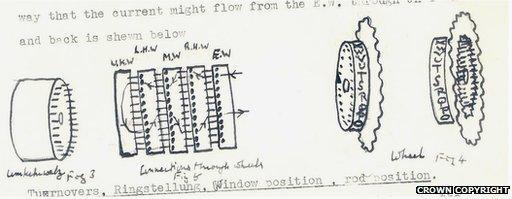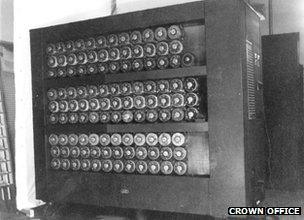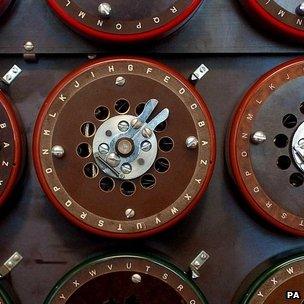Alan Turing: The codebreaker who saved 'millions of lives'
- Published
Alan Turing - the Bletchley Park codebreaker - would have been 100 years old on 23 June had he lived to the present day.
To mark the occasion the BBC commissioned a week-long series of articles to explore his many achievements. This second essay examines the impact the British mathematician had on the outcome of World War II.

Turing's Treatise on Enigma helped break Germany's encrypted messages
Germany's Army, Air Force and Navy transmitted many thousands of coded messages each day during World War II.
These ranged from top-level signals, such as detailed situation reports prepared by generals at the battle fronts, and orders signed by Hitler himself, down to the important minutiae of war like weather reports and inventories of the contents of supply ships.
Thanks to Turing and his fellow codebreakers, much of this information ended up in allied hands - sometimes within an hour or two of it being transmitted.
The faster the messages could be broken, the fresher the intelligence that they contained, and on at least one occasion an intercepted Enigma message's English translation was being read at the British Admiralty less than 15 minutes after the Germans had transmitted it.

Turing helped adapt a device originally developed by Poland to create the bombe
On the first day of war, at the beginning of September 1939, Turing took up residence at Bletchley Park, the ugly Victorian Buckinghamshire mansion that served as the wartime HQ of Britain's top codebreakers.
There he was a key player in the battle to decrypt the coded messages generated by Enigma, the German military's typewriter-like cipher machine.
Bletchley's bombes
Turing pitted machine against machine. The prototype model of his anti-Enigma "bombe", named simply Victory, was installed in the spring of 1940.
His bombes turned Bletchley Park into a codebreaking factory. As early as 1943 Turing's machines were cracking a staggering total of 84,000 Enigma messages each month - two messages every minute.
Turing personally broke the form of Enigma that was used by the U-boats preying on the North Atlantic merchant convoys.
It was a crucial contribution. The convoys set out from North America loaded with vast cargoes of essential supplies for Britain, but the U-boats' torpedoes were sinking so many of the ships that Churchill's analysts said Britain would soon be starving.
"The only thing that ever really frightened me during the war was the U-boat peril," Churchill said later.
Just in time, Turing and his group succeeded in cracking the U-boats' communications to their controllers in Europe. With the U-boats revealing their positions, the convoys could dodge them in the vast Atlantic waste.

The bombe's operators read decrypted German messages by marking the position of its drums
The Turingery
Turing also searched for a way to break into the torrent of messages suddenly emanating from a new, and much more sophisticated, German cipher machine.
The British codenamed the new machine Tunny. The Tunny teleprinter communications network, a harbinger of today's mobile phone networks, spanned Europe and North Africa, connecting Hitler and the Army High Command in Berlin to the front-line generals.
Turing's breakthrough in 1942 yielded the first systematic method for cracking Tunny messages. His method was known at Bletchley Park simply as Turingery, and the broken Tunny messages gave detailed knowledge of German strategy - information that changed the course of the war.
"Turingery was our one and only weapon against Tunny during 1942-3", explains ninety-one year old Captain Jerry Roberts, once section leader in the main Tunny-breaking unit known as the Testery.
"We were using Turingery to read what Hitler and his generals were saying to each other over breakfast, so to speak."
Turingery was the seed for the sophisticated Tunny-cracking algorithms that were incorporated in Tommy Flowers' Colossus, the first large-scale electronic computer.
With the installation of the Colossi - there were ten by the end of the war - Bletchley Park became the world's first electronic computing facility.
Turing's work on Tunny was the third of the three strokes of genius that he contributed to the attack on Germany's codes, along with designing the bombe and unravelling U-boat Enigma.
Ending the war

Turing and Bletchley Park's other cryptologists helped counter the threat posed by Germany's U-boats
Turing stands alongside Churchill, Eisenhower, and a short glory-list of other wartime principals as a leading figure in the Allied victory over Hitler. There should be a statue of him in London among Britain's other leading war heroes.
Some historians estimate that Bletchley Park's massive codebreaking operation, especially the breaking of U-boat Enigma, shortened the war in Europe by as many as two to four years.
If Turing and his group had not weakened the U-boats' hold on the North Atlantic, the 1944 Allied invasion of Europe - the D-Day landings - could have been delayed, perhaps by about a year or even longer, since the North Atlantic was the route that ammunition, fuel, food and troops had to travel in order to reach Britain from America.
Harry Hinsley, a member of the small, tight-knit team that battled against Naval Enigma, and who later became the official historian of British intelligence, underlined the significance of the U-boat defeat.
Any delay in the timing of the invasion, even a delay of less than a year, would have put Hitler in a stronger position to withstand the Allied assault, Hinsley points out.

The UK government did not disclose details of the efforts to crack the Enigma machine until 1974
The fortification of the French coastline would have been even more formidable, huge Panzer Armies would have been moved into place ready to push the invaders back into the sea - or, if that failed, then to prevent them from crossing the Rhine into Germany - and large numbers of rocket-propelled V2 missiles would have been raining down on southern England, wreaking havoc at the ports and airfields tasked to support the invading troops.
Saved lives
In the actual course of events, it took the Allied armies a year to fight their way from the French coast to Berlin; but in a scenario in which the invasion was delayed, giving Hitler more time to prepare his defences, the struggle to reach Berlin might have taken twice as long.
At a conservative estimate, each year of the fighting in Europe brought on average about seven million deaths, so the significance of Turing's contribution can be roughly quantified in terms of the number of additional lives that might have been lost if he had not achieved what he did.
If U-boat Enigma had not been broken, and the war had continued for another two to three years, a further 14 to 21 million people might have been killed.
Of course, even in a counterfactual scenario in which Turing was not able to break U-boat Enigma, the war might still have ended in 1945 because of some other occurrence, also contrary-to-fact, such as the dropping of a nuclear weapon on Berlin. Nevertheless, these colossal numbers of lives do convey a sense of the magnitude of Turing's contribution.
<italic>Jack Copeland is professor of philosophy at the University of Canterbury, New Zealand. He has also built the </italic> <link> <caption>Turing Archive for the History of Computing</caption> <url href="http://www.alanturing.net/" platform="highweb"/> </link> <italic>, an extensive online resource.</italic>
- Published18 June 2012
- Published19 June 2012
- Published20 June 2012
- Published22 June 2012
- Published20 June 2012